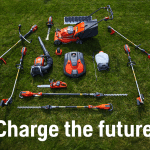
Between regulations, customer preferences and a desire to reduce emissions, there are numerous reasons to consider adding electric equipment to your fleets. But some companies aren’t just thinking about it; they’re going all in.
Why Do It?
“For me, it was really just ease of use,” says Daniel Cienfuegos, co-owner of Electrawn, LLC, based in Lakeland, Florida. “You’ll see the guys have to get oil, gas and all the maintenance that you had to do with gas equipment. The electric was just pretty much plug-and-go. Click a button and you don’t have to worry about it.”
Cienfuegos says it was hard to convince his co-owner Ronnie Rodriguez that switching to electric was a good idea, but they’ve been all-electric since 2020 and even rebranded the company to highlight the fact.

Bob Deasy, maintenance division manager for Blue Claw Associates, Inc., based in Osterville, Massachusetts, says they decided to go all-electric due to the regulations that were starting to be passed on Cape Cod. They wanted to get ahead of the game.
Stephen Gault, founder & CEO of EcoMow Lawn & Landscape, based in Dallas, Texas, started his company in 2019 after wondering if there was a market for an all-battery-powered lawn maintenance company after hearing the roar of a gas blower while out on a walk. Gault asked a friend who had a landscape company what he thought, and he said there was no way. As soon as Gault heard it wasn’t possible, he was motivated to make it work.
Without a single customer, he bought around $3,000 to $4,000 worth of Ego power equipment. He got a wrapped van and parked outside a Lowe’s until they got their first call. When COVID hit, the phone started ringing off the hook because people were working from home and looking for a quieter maintenance company.
“After that third phone call from somebody right after COVID hit, I looked at my wife and I said, ‘Oh my God, we’ve got something here,’” Gault says.
Despite his lack of industry knowledge, Gault was aware that running an all-battery-powered maintenance company was going to be a challenge.
Always Be Charging
The common concern landscape company owners have with depending on battery-powered equipment is the run time. However, Cienfuegos says they typically don’t have to worry about it. They developed their own charging infrastructure in their trucks so they can charge on the go. He says ABC (Always Be Charging) is the name of the game with electric operations.
Cienfuegos says there was a lot of trial and error in the beginning. He ended up creating a calculator that lets them determine how many battery packs to go out with daily. He says their system is scalable and they can tailor it to their needs. Electrawn currently has two full crews and hopes to expand to a third one this year.
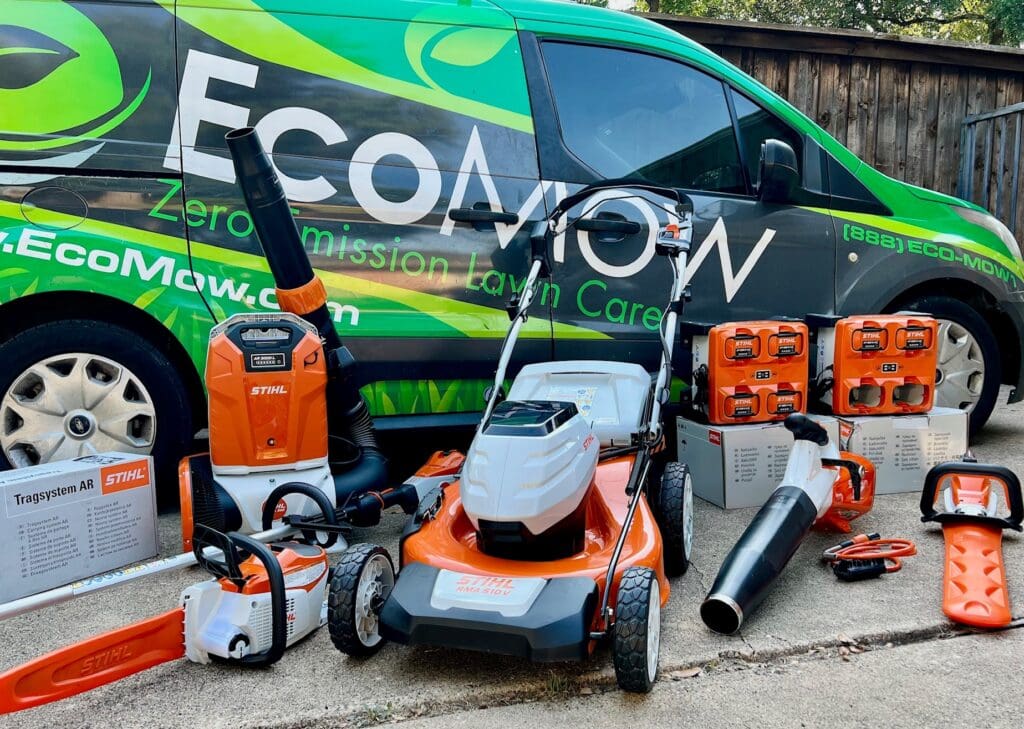
He says a more significant challenge for them is finding equipment that has the power they need.
“I’ve found a lot of the manufacturers worry about run time and since we have our own charging systems, I’m not really worried about run time,” Cienfuegos says. “Our biggest issue has been the power, making sure we have enough power on hand.”
Gault says one of the biggest challenges they had was not having enough batteries to service their customers, so they developed an onboard charging system in their vehicles as well.
“The use of onboard large capacity lithium batteries paired with Renogy onboard power inverters to power our chargers,” Gault says. “We also have solar panels on our vehicles to help keep the onboard house battery topped up throughout the day.”
Gault says with the crew regularly charging throughout the day, they put 10 batteries on each of their vehicles. They currently have two maintenance crews and one landscape enhancement team.
“There’s a workflow that is certainly different than what a lot of these guys are traditionally used to,” Gault says. “They have to be constantly cycling batteries and making sure that the batteries are on the chargers. I would think that power management is probably the biggest learning curve to keep these guys going in the field.”
Gault says they found the low-watt chargers from many brands don’t serve them well in the field because the charge time is too long.
“We use fast chargers in the field and save the slow chargers for overnight charging in the shop,” Gault says. “We’ve been exploring DC to DC charging recently as it’s clearly the direction the business is headed and allows for a much more rapid charge rate so we can carry less batteries on the trucks.”
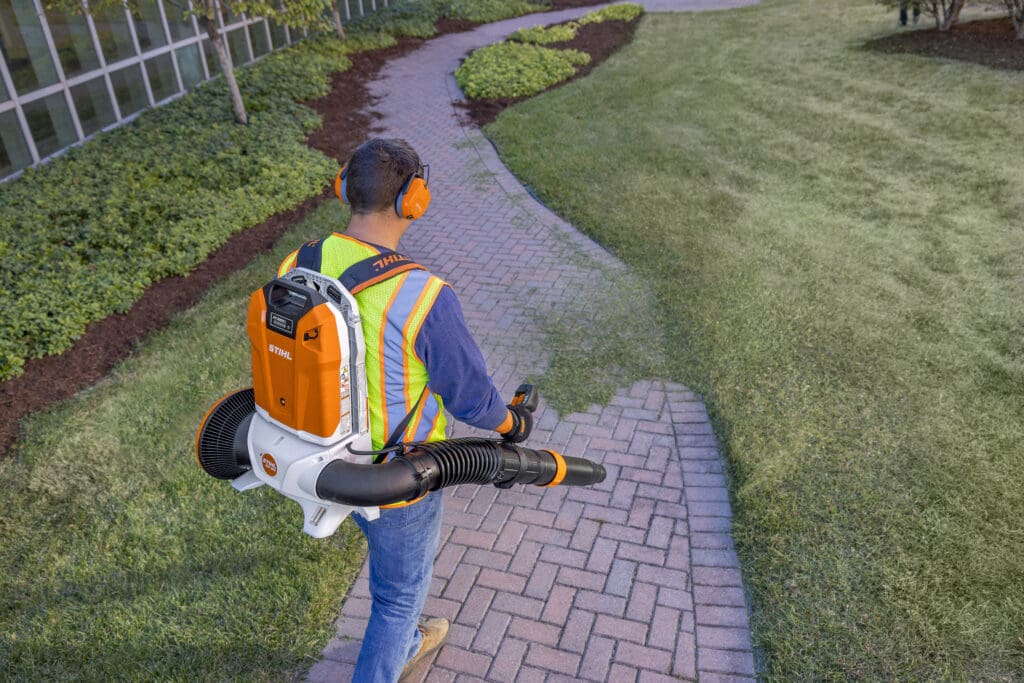
Blue Claw also has trucks and trailers set up with solar panels on the roof that can charge the batteries throughout the day. They have five all-electric crews. Deasy says they also charge the batteries overnight.
“Our trucks are set up similar to an RV or a camper where it has turned 240-volt plug that we plug in at 20 amps, so we had to have an electrician come in, put a few new breakers in the box and then put larger outlets on the wall to appropriately charge our equipment,” Deasy says.
Through trial and error, Blue Claw figured out their ideal number of batteries per crew. Deasy notes it’s not affordable to buy enough batteries to get you through the day without charging.
“My opinion is it’s a better investment to spend a few $100 to charge something throughout the day and only have four or five batteries instead of having 15 to 20 batteries,” Deasy says. “I think it’s a more affordable option for someone who’s trying to start up to see if it is sustainable for them.”
Deasy says other companies need to make sure they’re ready for the investment.
“It’s more out of pocket and you need to ensure you have a way to charge your equipment in the field,” Deasy says. “There’s no way you can make it through the day without constantly charging batteries.”
Productivity Levels and Employee Buy-In
Another common question is the productivity levels of an all-electric fleet. Cienfuegos feels they are on par with gas equipment and possibly slightly better at efficiency because they do not have to stop to fuel up or buy more gas throughout the day. As for blowers, he says in his region, they work just fine because they only need to blow off grasses. They don’t have heavy amounts of leaves like up North.
Deasy says the only piece of equipment they’ve had issues with is the blowers due to their decreased run time. He admits that they might be a little slower than a gas-powered crew simply because the electric blowers make spring and fall cleanups take a bit longer.

Gault agrees that the blowers go through a lot of batteries, particularly during leaf season.
“Comparing it to gas, I certainly think it takes a little bit more time,” Gault says. “On the maintenance side, a gas-powered crew would get done in 20 minutes and an electric crew, it’s probably going to take about 25 minutes.”
Starting out, Blue Claw’s crews believed the stigma that electric equipment couldn’t perform as well as gas-powered equipment.
“Once the crews started using the equipment, they realized that it was very comparable,” Deasy says. “The only thing that really isn’t comparable is blowers. We budget our jobs, the amount of time the crew has to complete the job around whether we’re going to be doing a significant amount of blowing or not. So I think overall, it was pretty easy to get buy-in.”
Gault says his employees love that they don’t have to wear protective ear coverings, the equipment has less vibration due to having brushless motors, and they don’t smell like gas at the end of the day.
Customer Demand
Deasy says scaling up has not been an issue being all-electric. They have grown exponentially in the past 18 months as there is a large demographic pushing for green equipment and green vehicles.
“It’s very easy to sell,” Deasy says. “I think nowadays, with work from home, a lot of people don’t want to hear blowers and mowers in their yard. I think it’s an easy push to customer bases, especially hotels, apartments, condo complexes, where you’re there for a long period of time with a crew working that these people don’t hear you.”
Gault adds that consumers aren’t concerned about a company being more eco-friendly with zero emissions.
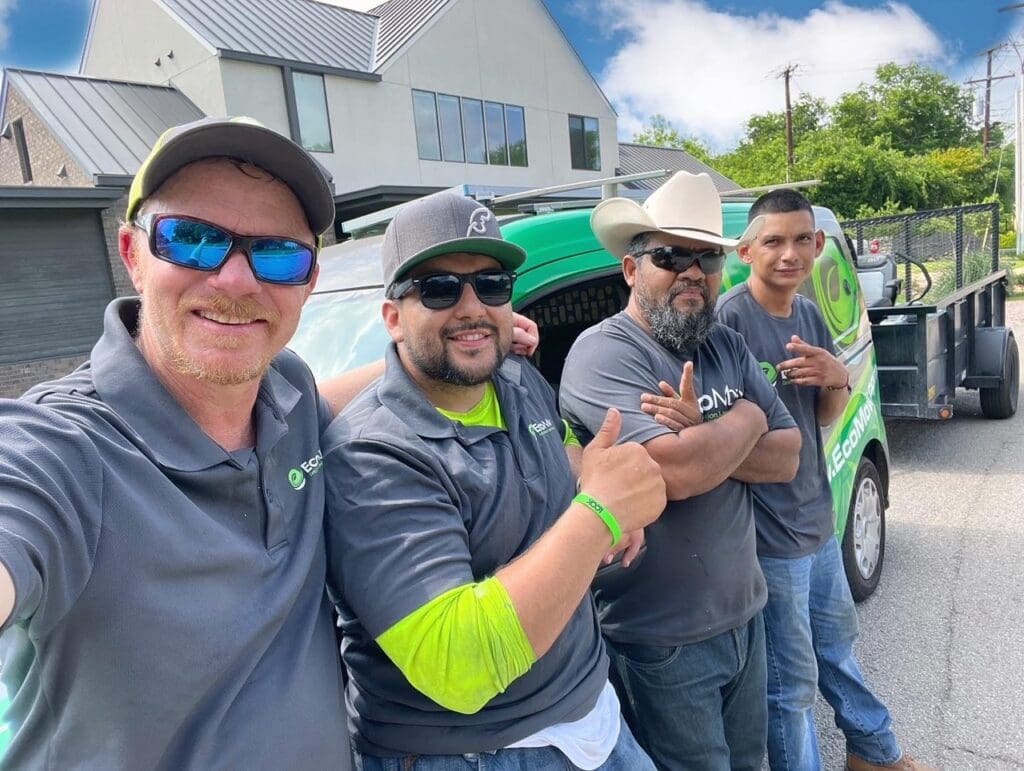
“The noise pollution element is what people care about,” Gault says. “They could care less, quite honestly, if we were gas-powered or electric, to most people, that does not matter. What does matter is the noise.”
Deasy estimates they charge customers three to five percent higher than their gas competitors in the area. He doesn’t think competing against gas-powered companies is hard because their customer base is looking for an all-electric service.
“People that want electric service will seek us out,” Deasy says. “But if someone picks up the phone because we’re a landscape company and has no idea, they don’t want to pay the higher prices for electric. They’re just looking for the cheapest landscape company.”
Cienfuegos says they’re priced similarly to other gas-powered companies. They are not more or less expensive. He says they don’t have clients seeking them out because they are all-electric but because they’re quiet.
“We also present ourselves as a premium brand,” Cienfuegos says. “Our guys are uniformed. Our trucks are wrapped. We pride ourselves on that, so that’s a couple of things that make us stand out from others.”
Gault says while their prices are higher than a typical lawn service company, this is not due to their electric equipment costs. He says they are providing quality and communication a step above the rest.
“At the end of the day, our customer service with modern amenities like client portals, dispatch automation, auto-billing, card on file, etc., add to our elite service,” Gault says. “Pair this with the fact that our service is significantly quieter, and we’ve got a winning combination. Noise pollution is a big player in why our clients don’t mind paying a premium.”
Lessons Learned
All three companies have learned the importance of finding durable equipment brands.
“We’ve had some issues with tools that have failed us prematurely as we’re very early in battery-powered tool development, which has resulted in our switching brands several times over the years,” Gault says. “Durability and reliability of tools has been a struggle for us in the past.”
Deasy encourages figuring out which brands offer warranties for their chargers, batteries and equipment.

Because Electrawn developed their own charging system, Cienfuegos says they can switch between various brands versus having to commit to one. He says they are trying to standardize because they want equipment that has the best warranties and still performs the job well.
“We’re looking at efficiency as in cost-effectiveness over the lifespan of the equipment,” Cienfuegos says. “If the equipment has a four-year warranty or a three-year warranty and the battery has a three-year warranty, that’s more important to us than a very strong and very great product that only has a 90-day warranty.”
Testing out various electric equipment brands can be cost-prohibitive.
“It’s significantly more expensive than gas, so you got to make the right decision,” Deasy says. “It’s tough to test it, to be honest. You have to buy a bunch of batteries to see if it’s going last all year. You’re going to put a good investment into testing things and I think that’ll hold a lot of people back.”
Deasy acknowledges testing out a handful of equipment is not the same as using it day in and day out. They were nervous about committing to one brand. They run Gravely electric mowers and their sales rep let them demo the mower for 15 days, which made the decision to purchase easier.
Cienfuegos says if you are a smaller company, start small and don’t purchase a large amount of batteries.
“You don’t need to spend a lot of money on a specific brand just for their batteries,” Cienfuegos says. “You can always switch if you have a versatile system to charge.”
Cienfuegos encourages others considering making the change to seek out experts and electric lawn maintenance groups. He is part of the Electric Lawn Talk, where various all-electric companies discuss topics related to electric lawn care and landscaping.
“Embrace the change because it’s the direction the business is headed and it’s not going away,” Gault says. “If you’re going to be a late adopter, which is absolutely fine, start with the hand tools. Reach out to other battery-powered companies and ask them for a bit of their time to learn what works and what doesn’t. You’ll save yourself a ton of time and a lot of headaches by asking folks like us.”
This article was published in the March/April issue of the magazine. To read more stories from The Edge magazine, click here to subscribe to the digital edition.


